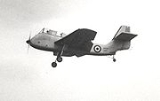
Short Seamew
Encyclopedia
The Short SB.6 Seamew was a British
aircraft designed in 1951 by David Keith-Lucas
of Shorts
as a lightweight anti-submarine platform to replace the Royal Navy
Fleet Air Arm (FAA)
's Grumman Avenger AS 4 with the Reserve branch of the service. It first flew on 23 August 1953, but, due to poor performance coupled with shifting defence doctrine, it never reached service and only 19 were built before the project was cancelled. It has been described as a "camel amongst race-horses".
Specification M.123D for a simple, lightweight anti-submarine aircraft capable of unassisted operation from any of the Royal Navy
's aircraft carrier
s in all but the worst of conditions. Although specifically designed for naval operations, the Seamew was also intended for land-based use by the RAF. It was to be suitable for mass production and operation by the Air Branch of the Royal Naval Volunteer Reserve (RNVR)
. This specification was in response to the alarming increase in capabilities of the Soviet
submarine forces following the Second World War
.
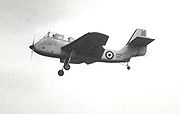 Three prototypes were ordered in April 1952 and the first flight (XA209), piloted by its test pilot, Sqn. Ldr.
Three prototypes were ordered in April 1952 and the first flight (XA209), piloted by its test pilot, Sqn. Ldr.
Walter J. "Wally" Runciman, took place on 23 August 1953. This same aircraft, also piloted by Runciman, took part in the 1953 Farnborough Airshow three weeks later. In 1954 both XA209 and the second prototype XA213 took part at Farnborough, where the following year both prototypes and two production AS Mk 1 models (XE171 and XE172) gave a formation display.
The fourth Seamew prototype (XE175) was flown by Runciman for a series of sales tours in 1956 to Italy (March), Yugoslavia (April) and West Germany (May). It was this same aircraft in which Runciman was killed when it crashed during the Sydenham (Belfast) Air Display on 9 June 1956. Rumours that the crash had been caused by a material failure were current at the time but the accident investigation board did not confirm them.
The MR Mark 2 for use by Coastal Command was similar in every respect to the AS Mk 1 except that it was optimised for land-based use from hastily prepared airstrips. Naval equipment was deleted although manual wing folding was retained. Slightly heavier than the naval version, the MR Mk 2 had oversize low pressure tyres and could carry a higher weapons load.
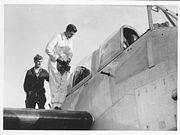
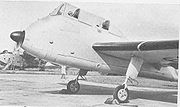


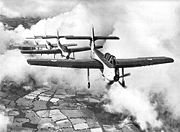 The pilot and observer were located in tandem cockpits located high up in the front of the deep, narrow fuselage creating a decidedly "curious" profile. They sat atop the Armstrong Siddeley
The pilot and observer were located in tandem cockpits located high up in the front of the deep, narrow fuselage creating a decidedly "curious" profile. They sat atop the Armstrong Siddeley
Mamba turboprop
in front and the weapons bay to the rear of them. The design had originally called for the tried and tested Rolls-Royce Merlin
piston engine but the Royal Navy had made it policy to phase out piston engines, in order that supplies of highly flammable high octane
aviation fuel
need not be carried in large quantities on ships. The turboprop engine also caused less airframe vibration so the pilot could be sat directly over it and the absence of a piston engine ignition system which would have interefered with the radar scanner mounted below the engine housing.
For simplicity, and so that a nose wheel would not obscure the forward field of the radar scanner, a fixed tail wheel undercarriage was used. The long stroke necessary on the main undercarriage to allow for heavy deck landings while giving the radar scanner and propeller adequate clearance from the ground resulted in an alarming attitude on the ground and the cockpits mounted at a seemingly perilous height. For landing the tail wheel extended so it could land at a more level attitude.
The pilot and observer sat very far forward in order that the pilot could have a reasonable field of downward vision for takeoff and landing and so that both he and the observer had a good field of view for spotting surface vessels even when in level flight.
The large, broad-chord wings featured power-folding and pylons for the carriage of rocket
s, depth charge
s, flares
and small bombs
. The large, slab-like, tailplane was mounted high on the vertical stabiliser, requiring the rudder to be split into upper and lower sections. The fixed undercarriage legs could be jettisoned in the event of ditching.
The weapons bay was 14 ft long and 3 ft wide. By omitting the rotating radar scanner it could be extended to 17 ft in order to carry longer weapons.
s and slats added to the tailplane roots. Although something of an improvement over the initial models, the handling was never wholly satisfactory. Arthur Pearcy wrote "only Short Brothers' test pilot Wally Runciman seemed able to outwit its vicious tendencies and exploit its latent manoeuvrability to the limit."
The stall speed of the Seamew was 50 kt and it required only 50% of engine power to maintain flight. Runciman said "take off and landing are simple and straightforward", "it is, in fact, impossible to bounce the Seamew", and that it's performance in crosswinds was "outstanding".
and RAF
), with Seamew XA213 successfully completing carrier trials on HMS Bulwark
in July and December 1955. Naval service flight trials with two Seamews were carried out with 700 Naval Air Squadron in November 1956, which included catapult trials and around 200 takeoffs and landings on HMS Warrior
.
The RAF lost interest after four Mk 2s were built with three of them converted to AS1 standard; the fourth (XE175) was flown by S/L W. "Wally" J. Runciman for a series of sales tours in 1956 to Italy (March), Yugoslavia (April) and West Germany (May).
Meanwhile the FAA decided that the RNVR Avengers would be replaced by Seamews, but only four had been taken on charge by the time the RNVR squadrons were disbanded in March 1957 in keeping with the 1957 Defence White Paper
, before any Seamews were allocated to them. Seven aircraft eventually delivered to the FAA were scrapped at RNAS Lossiemouth
, and the other 11, complete and awaiting delivery, were scrapped at Sydenham. The last surviving Seamew, XE180 which had been purchased by Shorts on 31 August 1959 for ground instruction at its Apprentice Training School, was scrapped in 1967.
The Rolls-Royce Heritage Trust
has preserved a Seamew engine, which is found at its Coventry branch.
United Kingdom
The United Kingdom of Great Britain and Northern IrelandIn the United Kingdom and Dependencies, other languages have been officially recognised as legitimate autochthonous languages under the European Charter for Regional or Minority Languages...
aircraft designed in 1951 by David Keith-Lucas
David Keith-Lucas
David Keith-Lucas CBE was an aeronautical engineer.-Early life:David Keith-Lucas was one of the sons of Keith Lucas, who invented the first aeronautical compass. He was educated at Gresham's School, Holt, and at Gonville and Caius College, Cambridge, where he read engineering.-Career:He was an...
of Shorts
Short Brothers
Short Brothers plc is a British aerospace company, usually referred to simply as Shorts, that is now based in Belfast, Northern Ireland. Founded in 1908, Shorts was the first company in the world to make production aircraft and was a manufacturer of flying boats during the 1920s, 1930s, and 1940s...
as a lightweight anti-submarine platform to replace the Royal Navy
Royal Navy
The Royal Navy is the naval warfare service branch of the British Armed Forces. Founded in the 16th century, it is the oldest service branch and is known as the Senior Service...
Fleet Air Arm (FAA)
Fleet Air Arm
The Fleet Air Arm is the branch of the British Royal Navy responsible for the operation of naval aircraft. The Fleet Air Arm currently operates the AgustaWestland Merlin, Westland Sea King and Westland Lynx helicopters...
's Grumman Avenger AS 4 with the Reserve branch of the service. It first flew on 23 August 1953, but, due to poor performance coupled with shifting defence doctrine, it never reached service and only 19 were built before the project was cancelled. It has been described as a "camel amongst race-horses".
Design and development
The Short Seamew was selected to fulfill AdmiraltyAdmiralty
The Admiralty was formerly the authority in the Kingdom of England, and later in the United Kingdom, responsible for the command of the Royal Navy...
Specification M.123D for a simple, lightweight anti-submarine aircraft capable of unassisted operation from any of the Royal Navy
Royal Navy
The Royal Navy is the naval warfare service branch of the British Armed Forces. Founded in the 16th century, it is the oldest service branch and is known as the Senior Service...
's aircraft carrier
Aircraft carrier
An aircraft carrier is a warship designed with a primary mission of deploying and recovering aircraft, acting as a seagoing airbase. Aircraft carriers thus allow a naval force to project air power worldwide without having to depend on local bases for staging aircraft operations...
s in all but the worst of conditions. Although specifically designed for naval operations, the Seamew was also intended for land-based use by the RAF. It was to be suitable for mass production and operation by the Air Branch of the Royal Naval Volunteer Reserve (RNVR)
Royal Naval Reserve
The Royal Naval Reserve is the volunteer reserve force of the Royal Navy in the United Kingdom. The present Royal Naval Reserve was formed in 1958 by merging the original Royal Naval Reserve and the Royal Naval Volunteer Reserve , a reserve of civilian volunteers founded in 1903...
. This specification was in response to the alarming increase in capabilities of the Soviet
Soviet Union
The Soviet Union , officially the Union of Soviet Socialist Republics , was a constitutionally socialist state that existed in Eurasia between 1922 and 1991....
submarine forces following the Second World War
World War II
World War II, or the Second World War , was a global conflict lasting from 1939 to 1945, involving most of the world's nations—including all of the great powers—eventually forming two opposing military alliances: the Allies and the Axis...
.

Squadron Leader
Squadron Leader is a commissioned rank in the Royal Air Force and the air forces of many countries which have historical British influence. It is also sometimes used as the English translation of an equivalent rank in countries which have a non-English air force-specific rank structure. In these...
Walter J. "Wally" Runciman, took place on 23 August 1953. This same aircraft, also piloted by Runciman, took part in the 1953 Farnborough Airshow three weeks later. In 1954 both XA209 and the second prototype XA213 took part at Farnborough, where the following year both prototypes and two production AS Mk 1 models (XE171 and XE172) gave a formation display.
The fourth Seamew prototype (XE175) was flown by Runciman for a series of sales tours in 1956 to Italy (March), Yugoslavia (April) and West Germany (May). It was this same aircraft in which Runciman was killed when it crashed during the Sydenham (Belfast) Air Display on 9 June 1956. Rumours that the crash had been caused by a material failure were current at the time but the accident investigation board did not confirm them.
The MR Mark 2 for use by Coastal Command was similar in every respect to the AS Mk 1 except that it was optimised for land-based use from hastily prepared airstrips. Naval equipment was deleted although manual wing folding was retained. Slightly heavier than the naval version, the MR Mk 2 had oversize low pressure tyres and could carry a higher weapons load.
Design





Armstrong Siddeley
Armstrong Siddeley was a British engineering group that operated during the first half of the 20th century. It was formed in 1919 and is best known for the production of luxury motor cars and aircraft engines.-Siddeley Autocars:...
Mamba turboprop
Turboprop
A turboprop engine is a type of turbine engine which drives an aircraft propeller using a reduction gear.The gas turbine is designed specifically for this application, with almost all of its output being used to drive the propeller...
in front and the weapons bay to the rear of them. The design had originally called for the tried and tested Rolls-Royce Merlin
Rolls-Royce Merlin
The Rolls-Royce Merlin is a British liquid-cooled, V-12, piston aero engine, of 27-litre capacity. Rolls-Royce Limited designed and built the engine which was initially known as the PV-12: the PV-12 became known as the Merlin following the company convention of naming its piston aero engines after...
piston engine but the Royal Navy had made it policy to phase out piston engines, in order that supplies of highly flammable high octane
Octane
Octane is a hydrocarbon and an alkane with the chemical formula C8H18, and the condensed structural formula CH36CH3. Octane has many structural isomers that differ by the amount and location of branching in the carbon chain...
aviation fuel
Aviation fuel
Aviation fuel is a specialized type of petroleum-based fuel used to power aircraft. It is generally of a higher quality than fuels used in less critical applications, such as heating or road transport, and often contains additives to reduce the risk of icing or explosion due to high temperatures,...
need not be carried in large quantities on ships. The turboprop engine also caused less airframe vibration so the pilot could be sat directly over it and the absence of a piston engine ignition system which would have interefered with the radar scanner mounted below the engine housing.
For simplicity, and so that a nose wheel would not obscure the forward field of the radar scanner, a fixed tail wheel undercarriage was used. The long stroke necessary on the main undercarriage to allow for heavy deck landings while giving the radar scanner and propeller adequate clearance from the ground resulted in an alarming attitude on the ground and the cockpits mounted at a seemingly perilous height. For landing the tail wheel extended so it could land at a more level attitude.
The pilot and observer sat very far forward in order that the pilot could have a reasonable field of downward vision for takeoff and landing and so that both he and the observer had a good field of view for spotting surface vessels even when in level flight.
The large, broad-chord wings featured power-folding and pylons for the carriage of rocket
Rocket
A rocket is a missile, spacecraft, aircraft or other vehicle which obtains thrust from a rocket engine. In all rockets, the exhaust is formed entirely from propellants carried within the rocket before use. Rocket engines work by action and reaction...
s, depth charge
Depth charge
A depth charge is an anti-submarine warfare weapon intended to destroy or cripple a target submarine by the shock of exploding near it. Most use explosives and a fuze set to go off at a preselected depth in the ocean. Depth charges can be dropped by either surface ships, patrol aircraft, or from...
s, flares
Flare (pyrotechnic)
A flare, also sometimes called a fusee, is a type of pyrotechnic that produces a brilliant light or intense heat without an explosion. Flares are used for signalling, illumination, or defensive countermeasures in civilian and military applications...
and small bombs
Bomb
A bomb is any of a range of explosive weapons that only rely on the exothermic reaction of an explosive material to provide an extremely sudden and violent release of energy...
. The large, slab-like, tailplane was mounted high on the vertical stabiliser, requiring the rudder to be split into upper and lower sections. The fixed undercarriage legs could be jettisoned in the event of ditching.
The weapons bay was 14 ft long and 3 ft wide. By omitting the rotating radar scanner it could be extended to 17 ft in order to carry longer weapons.
Handling characteristics
The handling characteristics of the Seamew were poor. The prototypes were heavily modified with fixed leading-edge slats, slots added in the trailing-edge flaps, alterations to the aileronAileron
Ailerons are hinged flight control surfaces attached to the trailing edge of the wing of a fixed-wing aircraft. The ailerons are used to control the aircraft in roll, which results in a change in heading due to the tilting of the lift vector...
s and slats added to the tailplane roots. Although something of an improvement over the initial models, the handling was never wholly satisfactory. Arthur Pearcy wrote "only Short Brothers' test pilot Wally Runciman seemed able to outwit its vicious tendencies and exploit its latent manoeuvrability to the limit."
The stall speed of the Seamew was 50 kt and it required only 50% of engine power to maintain flight. Runciman said "take off and landing are simple and straightforward", "it is, in fact, impossible to bounce the Seamew", and that it's performance in crosswinds was "outstanding".
Operational service
An order was placed in February 1955 for 60 aircraft (split evenly between the FAAFleet Air Arm
The Fleet Air Arm is the branch of the British Royal Navy responsible for the operation of naval aircraft. The Fleet Air Arm currently operates the AgustaWestland Merlin, Westland Sea King and Westland Lynx helicopters...
and RAF
Royal Air Force
The Royal Air Force is the aerial warfare service branch of the British Armed Forces. Formed on 1 April 1918, it is the oldest independent air force in the world...
), with Seamew XA213 successfully completing carrier trials on HMS Bulwark
HMS Bulwark (R08)
The sixth HMS Bulwark of the Royal Navy was a 22,000 tonne Centaur-class light fleet aircraft carrier.-Construction:Bulwark was laid down by the Harland & Wolff shipyard in Belfast on 10 May 1945...
in July and December 1955. Naval service flight trials with two Seamews were carried out with 700 Naval Air Squadron in November 1956, which included catapult trials and around 200 takeoffs and landings on HMS Warrior
HMS Warrior (R31)
HMS Warrior was a Colossus-class light aircraft carrier which served in the Royal Canadian Navy from 1946 to 1948 , the Royal Navy from 1948 to 1958, and the Argentine Navy from 1959 to 1969 .- History :Built by Harland and Wolff in Belfast, she was originally to be called HMS Brave; the Royal...
.
The RAF lost interest after four Mk 2s were built with three of them converted to AS1 standard; the fourth (XE175) was flown by S/L W. "Wally" J. Runciman for a series of sales tours in 1956 to Italy (March), Yugoslavia (April) and West Germany (May).
Meanwhile the FAA decided that the RNVR Avengers would be replaced by Seamews, but only four had been taken on charge by the time the RNVR squadrons were disbanded in March 1957 in keeping with the 1957 Defence White Paper
1957 Defence White Paper
The 1957 White Paper on Defence was a British white paper setting forth the perceived future of the British military. It had profound effects on all aspects of the defence industry but probably the most affected was the British aircraft industry...
, before any Seamews were allocated to them. Seven aircraft eventually delivered to the FAA were scrapped at RNAS Lossiemouth
RAF Lossiemouth
RAF Lossiemouth is a Royal Air Force station to the west of the town of Lossiemouth in Moray, Scotland. It is one of the RAF's biggest bases and is currently Britain's main base for Tornado GR4s. From 2013 the Northern QRA force of Typhoon F2 will relocate to Lossiemouth following the closure of...
, and the other 11, complete and awaiting delivery, were scrapped at Sydenham. The last surviving Seamew, XE180 which had been purchased by Shorts on 31 August 1959 for ground instruction at its Apprentice Training School, was scrapped in 1967.
The Rolls-Royce Heritage Trust
Rolls-Royce Limited
Rolls-Royce Limited was a renowned British car and, from 1914 on, aero-engine manufacturing company founded by Charles Stewart Rolls and Henry Royce on 15 March 1906 as the result of a partnership formed in 1904....
has preserved a Seamew engine, which is found at its Coventry branch.
Specifications (Seamew AS 1)
See also
External links
- Short Seamew Keith-Lucas, D; 1956 Flight
- Short Seamew AS1
- Types

